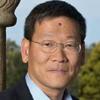Precourt Institute Fellows
24 Stanford faculty members are fellows of the Precourt Institute for Energy. They help identify new initiatives, support existing initiatives, set strategic direction, and build bridges to their colleagues across schools, disciplines and programs. Their personal research and expertise in energy is listed below. Some of the fellows also engage in research not related to energy, which is not described here. Names link to Stanford employee directory listings. Terms for filtering under “Energy Research Area” are divided into categories provided in capital letters, e.g. “END USE/EFFICIENCY” “ENVIRONMENTAL IMPACTS,” and “POLICY & ECONOMICS.” Users can filter for specific areas or the entire category.
Please send comments and suggestions to: mark.golden@stanford.edu.
Department/Research Program:
Energy Resources Engineering, Global Climate & Energy Project, Precourt Institute
Energy Research Area:
Climate, CO2 Capture, Storage & Conversion
Sequestering CO2 in deep underground formations. Permeability of CO2 and brine, especially sensitivity to injection flow-rate and various fluid properties. Net energy analysis of emerging technologies, such as PV and energy storage.Energy systems analysis to guide decisions about providing energy while reducing GHG emissions.
Department/Research Program:
Chemical Engineering, TomKat Center for Sustainable Energy
Energy Research Area:
Batteries & Fuel Cells, Photovoltaics, Renewable Fuels
Understanding and controlling surface and interfacial chemistry, and materials synthesis. Applying this to new materials and processes for next generation low-cost solar cells, fuel cells and catalysts.
Department/Research Program:
Energy Resources Engineering
Energy Research Area:
Climate, CO2 Capture, Storage & Conversion, Natural Gas, Unconventional Oil & Gas
Reducing the environmental impacts of energy systems. Methane leaks from US natural gas system. Analysis of CO2 capture technologies. Life-cycle analysis of transportation fuels. Modeling global oil depletion, or "peak oil," and transitions to oil substitutes.
Department/Research Program:
Materials Science & Engineering, Precourt Institute
Energy Research Area:
Batteries & Fuel Cells, Renewable Fuels
Fundamental and applied electrochemistry: solar fuels, fuel cells, and batteries.
Department/Research Program:
SLAC - Photon Science, Stanford Institute for Materials & Energy Science
Energy Research Area:
Batteries & Fuel Cells, Photovoltaics, Superconductors
Modern computational approaches to electron and photon dynamics. Models for new energy paradigms for developing novel materials for superconductors, photovoltaics and batteries.
Department/Research Program:
Mechanical Engineering
Energy Research Area:
CO2 Capture, Storage & Conversion, Combustion, Transportation
Efficient, low-polluting transportation engines (piston and turbine) by taking reactants to extreme states of energy density, and advanced electric generation. Sootless diesel engine. Coal-fired power with CO2 capture via combustion in supercritical saline aquifer water.
Department/Research Program:
Biology, Carnegie - Global Ecology, Earth System Science
Energy Research Area:
Climate, Land Use, Bioenergy
Integrating large-scale solar projects with biofuel production in deserts. Impacts on climate of converting land use from food to biofuel crops. Climate benefits of converting biofuel crops from annual plants to perennials. Global potential of bioenergy.
Department/Research Program:
Civil & Environmental Engineering, Precourt Energy Efficiency Center
Energy Research Area:
Buildings
Virtual design and construction.
Department/Research Program:
Economics, Hoover Task Force on Energy Policy, Stanford Environmental & Energy Policy Analysis Center
Energy Research Area:
Energy Markets, Law, Tax & Regulation
The environmental and economic impacts of U.S. and international environmental policies, including policies to deal with climate change, and with pollution from power plants and automobiles. Strengths and weaknesses of a carbon tax. Design of cap-and-trade systems. Obama administration's "Clean Power Plan."
Department/Research Program:
Energy Resources Engineering
Energy Research Area:
Enhanced Oil Recovery, Unconventional Oil & Gas, Geothermal
Geothermal, oil and gas reservoir engineering. Energy production optimization. Enhanced geothermal systems. Well test interpretation. Tracer analysis of fractures.
Department/Research Program:
Earth System Science, Precourt Institute, Stanford Woods Institute for the Environment
Energy Research Area:
Air Quality, Climate, Water, Unconventional Oil & Gas, Tax & Regulation
Produce scientific knowledge to guide policies on energy extraction and global warming. Environmental costs and benefits of hydraulic fracturing, especially on local water, air, human health and climate. Gas leaks in urban distribution systems. China's gas industry.
Department/Research Program:
Civil & Environmental Engineering
Energy Research Area:
Air Quality, Climate, Integrated Modeling, Wind
Developing large-scale clean, renewable energy solutions to global warming, air pollution and energy security. Modeling energy's effects on health and climate. Quantifying wind, water, and solar energy resources and reducing the impacts of their intermittency. Potential damping effect of large, ocean-based wind farms on hurricanes.
Department/Research Program:
Chemistry
Energy Research Area:
Batteries & Fuel Cells, Nuclear, Photovoltaics
Materials for the reversible sequestration of pollutants and for electro- and photo-catalytic conversions relevant for clean energy. Capturing atmospheric CO2 using organic-inorganic hybrid materials.
Department/Research Program:
Precourt Institute, Stanford Environmental & Energy Policy Analysis Center
Energy Research Area:
Energy Markets, Finance & Subsidies, Law, Tax & Regulation
Environmental economics and industrial organization, with a focus on climate change and energy markets. Uncertainty and learning in strategic contexts regarding the provision of public goods, mostly in the context of international environmental agreements.
Department/Research Program:
Mechanical Engineering, Precourt Institute
Energy Research Area:
Thermoelectrics, Batteries & Fuel Cells, Electric Grid, Grid Scale Storage, Climate, CO2 Capture, Storage & Conversion, Finance & Subsidies, Management & Innovation, Renewable Fuels
Using electrochemical reactions for thermal energy conversion. Thermochemical water-splitting reactions to produce carbon-free hydrogen. Re-engineering the electricity grid.
Department/Research Program:
Materials Science & Engineering
Energy Research Area:
Batteries & Fuel Cells, Photovoltaics
Thin films, especially complex metal oxides. Metal-oxide semiconductor anodes for oxidation of water. Low-to-intermediate temperature solid oxide fuel cells. Multijunction nanowire solar cells.
Department/Research Program:
Chemical Engineering, SLAC - Photon Science, SUNCAT Center for Interface Science & Catalysis
Energy Research Area:
Batteries & Fuel Cells, CO2 Capture, Storage & Conversion, Bioenergy, Renewable Fuels
Understanding interface phenomena, including adsorption, surface chemical reactions, heterogeneous catalysis, and photo- and electro-catalysis. Applications include solar fuel production, syngas reactions, biomass conversion, fuel cells, and battery processes.
Department/Research Program:
Electrical Engineering
Energy Research Area:
Green Computing, Thermoelectrics, Photovoltaics
Nanomaterials for energy-efficient electronics, including transistors, data storage, integrated circuits, and sensors. Energy harvesting through thermoelectrics. Carbon nanotubes, graphene, and other 2D materials for electronic and thermal applications. Fundamental limits of current and heat flow at the nanoscale.
Department/Research Program:
Materials Science & Engineering, Mechanical Engineering
Energy Research Area:
Batteries & Fuel Cells, Photovoltaics
Quantum confined solar cells, including quantum dots, thin barrier layers and transparent electrodes. Solid oxide fuel cells. Photosynthetic membranes and their catalytic behavior.
Department/Research Program:
Civil & Environmental Engineering
Energy Research Area:
Buildings, Sensors & Data, Electric Grid, Energy Markets, Wind
Making renewable energy economical. Reducing wind power costs by improving forecasts and buying replacement power later. Matching solar supply with businesses that have price-sensitive demand.
Department/Research Program:
Communication
Energy Research Area:
Buildings, Energy & Behavior, Sensors & Data
Creation of a multiplayer game platform linked to home energy sensors to enable empirical research about how serious games can change consumer decisions about energy consumption.
Department/Research Program:
Hoover Task Force on Energy Policy, Precourt Institute, Program on Energy & Sustainable Development, SLAC
Energy Research Area:
Climate, Energy Markets, Integrated Modeling, Nuclear
Global energy system analysis. Energy policy and energy supply issues.Nuclear energy. Reliability versus cost trade-offs in wind energy investments in California.Science policy.
Department/Research Program:
Applied Physics, Physics, SLAC
Energy Research Area:
Batteries & Fuel Cells, Superconductors, Solar Thermal, Renewable Fuels
High-temperature cuprate and pnictide superconductors. Photon-enhanced thermionic emission devices, which use solar heat and light. Transition metal oxides as functional energy materials. Multi-scale imaging of energy materials. Diamondoids-nanostructured diamond.
Department/Research Program:
Management Science & Engineering, Precourt Energy Efficiency Center
Energy Research Area:
Buildings, Energy & Behavior, Heating & Cooling, Transportation, Climate, Integrated Modeling, Energy Markets, Finance & Subsidies, Law, Management & Innovation, Tax & Regulation
Energy efficiency technologies, policies and behavior. Energy and climate change policy analysis. Electricity and petroleum markets analysis. Implementation of California's global warming solutions act (AB32).
Department/Research Program:
Materials Science & Engineering, Precourt Energy Efficiency Center
Energy Research Area:
Buildings, Transportation, Climate, Integrated Modeling, Land Use, Economic Development & Equity, Energy Markets, Finance & Subsidies, Management & Innovation, Tax & Regulation
Analysis of global climate change policy options. Energy efficiency analysis. Energy technology assessment. Integrated assessment. Models for strategic planning. Venture capital formation for energy technologies. GHG emissions and economic implications of new shale gas supplies. Market valuation of renewable power plants' ecological benefits.
Department/Research Program:
Economics, Program on Energy & Sustainable Development
Energy Research Area:
Energy & Behavior, Electric Grid, Water, Energy Markets, Finance & Subsidies, Management & Innovation, Tax & Regulation
Energy market design and monitoring. Emissions permit market design, analysis and monitoring.Transmission expansion policy, design and analysis. Methods for least cost integration of intermittent renewable resources. Energy supply and water supply interactions. The impact of pricing and information provision on energy demand.
Department/Research Program:
Geophysics, Natural Gas Initiative
Energy Research Area:
Land Use, CO2 Capture, Storage & Conversion, Natural Gas, Unconventional Oil & Gas
Reservoir geomechanics with emphasis on shale gas and tight gas reservoirs, hydraulic fracturing, the occurrence of induced and triggered earthquakes, and the feasibility of long-termgeologic sequestration of CO2.






























